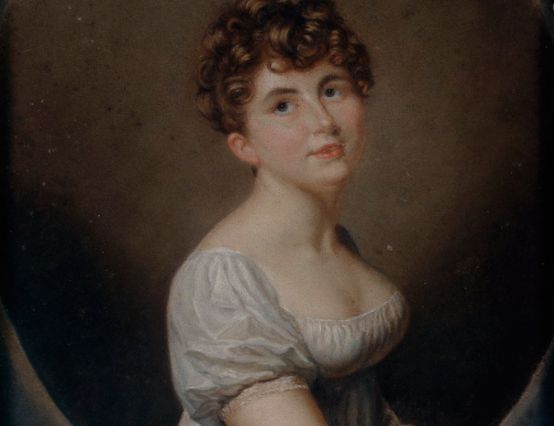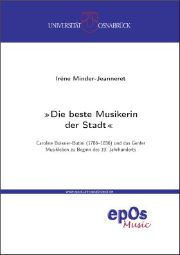The best musician in town
At the beginning of the 19th century, Caroline Boissier-Butini did not have an easy life in Calvinist Geneva, despite her upper-class background.

The translator, gender researcher and music publicist Irène Minder-Jeanneret created a comprehensive account of musical life in Geneva and, in connection with this, in Europe at the beginning of the 19th century in her doctoral thesis, based on the life of the almost forgotten pianist and composer Caroline Boissier-Butini.
The work, which is illustrated in color, clearly structured, with many tables and an extensive appendix, reflects the special position of this daughter who grew up in a complicated social constellation. She was encouraged in music by her grandfather and father and also instructed in the emerging sciences of the time (she would have liked to study medicine).
Irène Minder had actually planned to use the collected material to write a novel about Caroline Boissier-Butini. This is now being written in her head as she reads the dissertation, which is peppered with extensive diary entries, travel reports, letters and quotes from contemporary witnesses! The sources are insightfully annotated and interlinked in such a way that they provide a vivid picture of the period (all the French sources have been excellently translated into German).
The Calvinistically narrow, but thanks to Enlightenment ideas and the French Revolution broadened, then again oppressed by the Napoleonic occupation, conditions in the Geneva Republic resulted in very complex living conditions for Boissier-Butini. One result of this can be seen in her catalog of works: Although organ, piano and chamber music works have survived as manuscripts, the solo part of only one of her seven (!) piano concertos is extant. She was allowed to play for guests at home and in other salons befitting her status, but it was not appropriate for her to perform in public concerts, and certainly not for a salary. Daughters were not allowed to meet demoiselles of the same age; they were to remain in the sole company of their mother for as long as possible. According to Rousseau's conservative statements in his Lettre à d'Allembert and in the L'Émile the natural law perspective of women must take a back seat in favor of social necessity: Women were there for the well-being of their husbands and to bring up their children! It was not until 1838 that Albertine Necker-de Saussure fought for a change of course.
Fortunately, Caroline was married to the music-loving agronomist Auguste Boissier, who played his own two Stradivarius pianos and was very sympathetic to his wife's activities, dueting with her and performing in chamber music groups. Thanks to her privileged position, she was networked with many famous travelers and personalities using the Geneva exile (including Isabelle de Charrière, Germaine de Staël-Necker). Her talent enabled her to develop these inspirations into a mastery of piano playing and composition with limited tuition and above all self-taught. Elaborate trips to Paris and London to buy grand pianos, to try in vain to publish her compositions and to explore metropolitan culture introduced her to famous pianists, to whom she also played herself - earning recognition. Liszt, Kramer and Kalkbrenner's sensitive playing made her realize that she should create music that "touches instead of dazzles". She had her daughter Valérie taught by Liszt in Paris for a winter. Her report Liszt pédagogue first appeared in 1923 under the name "Mme Auguste Boissier", misleadingly reduced to "Auguste Boissier" in German in 1930! As the family lived on their country estate near Yverdon in the summer, she had the freedom to come into contact with ordinary people there, which encouraged her to become involved with folk music. Once, she quickly composed a few dances for a passing village fiddler for free. Her only performable Concerto No. 6 "La Suisse" contains all three elements of the Ranz des vaches.
Many obstacles hindered the development of her skills. Geneva's Calvinist tradition, which allowed music almost exclusively in the form of psalms, made the public performance of secular music difficult. Although she could play the organ and composed organ pieces, she was hardly allowed to play in church services. The Société de musique de Genève (1823), which was founded after Geneva's entry into the Confederation, only accepted women as non-voting members actives honoraires with limited opportunities to perform. Nevertheless, the music festivals held throughout Switzerland helped to establish a musical life in Geneva that was linked to the Confederation. Despite all this, Caroline Boissier-Butini played an outstanding role as a piano virtuoso, composer and music promoter that was also known in other Swiss cities, even though she only played privately everywhere.
Irène Minder-Jeanneret, "Die beste Musikerin der Stadt" Caroline Boissier-Butini (1786-1836) und das Genfer Musikleben zu Beginn des 19. Jahrhunderts, Dissertation University of Oldenburg; printed edition with additional material on CD-Rom, 528 p., € 44.90; edition on CD-Rom, € 24.90; EpOs Electronic Publishing, Osnabrück 2013, ISBN 978-3-940255-36-5








